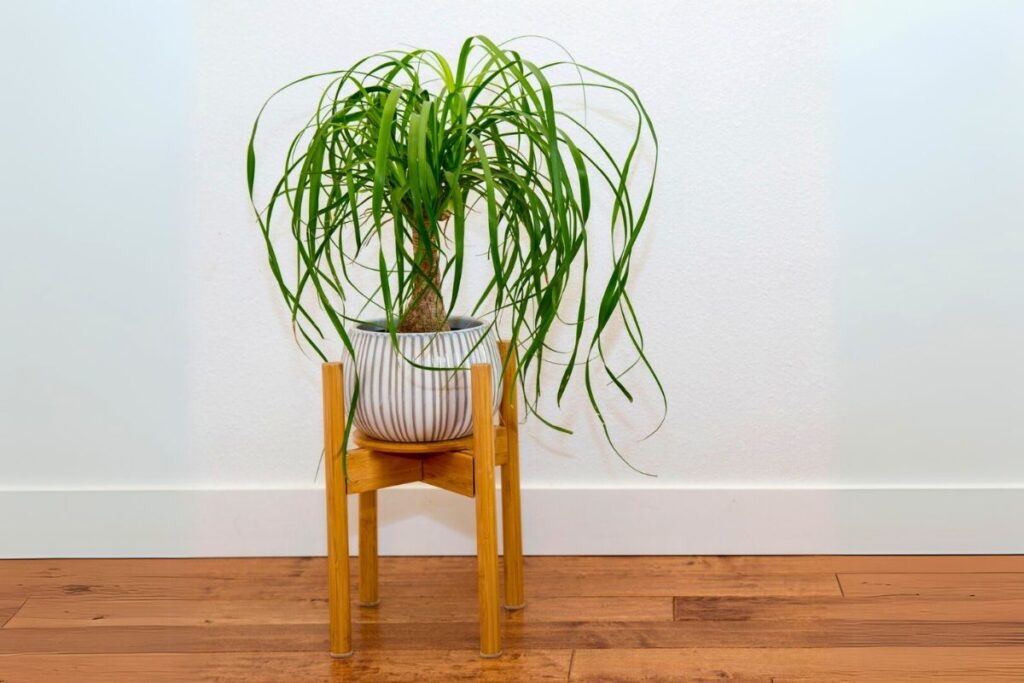Ponytail palms, also known as Beaucarnea recurvata or elephant foot palms, are a popular choice for indoor gardening due to their unique appearance and low-maintenance nature. With their bulbous trunks and cascading, strap-like leaves, these plants add a touch of whimsy and elegance to any space. Whether you’re a seasoned plant enthusiast or a beginner looking to add some greenery to your home, this guide will help you understand how to care for ponytail palms indoors.

Contents
Choosing the Right Location
Ponytail palms thrive in bright, indirect light but can tolerate low light conditions. Place your plant near a window where it can receive plenty of filtered sunlight. If natural light is limited, consider using a grow light to supplement its needs. Ponytail palms are quite adaptable and can do well in various lighting situations, making them a versatile addition to your indoor garden.
Maintaining Proper Temperature and Humidity
Ponytail palms prefer warm temperatures, typically between 60-80°F (15-27°C). They are relatively tolerant of dry air, making them suitable for indoor environments with lower humidity levels. However, if your home is particularly dry, you can mist the leaves occasionally or use a room humidifier to maintain optimal conditions. Avoid placing your plant near drafty windows or heating vents, as sudden temperature fluctuations can stress the plant.
Watering Wisely
One of the key aspects of ponytail palm care is proper watering. These plants are drought-tolerant and store water in their bulbous trunks, which means they don’t require frequent watering. Allow the soil to dry out completely between waterings, and then water thoroughly until excess water drains out of the bottom of the pot. Overwatering is the most common cause of problems for ponytail palms, so it’s better to err on the side of underwatering.
Soil and Fertilizing
Ponytail palms thrive in well-draining soil. A cactus or succulent potting mix works well, as it provides the right balance of moisture retention and aeration. If you’re using regular potting soil, consider adding sand or perlite to improve drainage. Feed your plant with a balanced, water-soluble fertilizer diluted to half strength every 4-6 weeks during the growing season. Reduce or stop fertilizing during the dormant period to prevent nutrient buildup.
Pruning and Maintenance
Ponytail palms require minimal pruning, but you can trim any dead or yellowing leaves to keep the plant looking tidy. If the leaves become too long and unruly, you can trim them back to maintain a more compact shape. Be sure to use clean, sharp scissors or pruning shears to make clean cuts and minimize damage to the plant.
Styling Your Ponytail Palm
Ponytail palms are versatile and can be styled in various ways to enhance your indoor decor. Here are some ideas to help you create a stunning display:
- Tall Floor Plant: Use a decorative pot and allow the plant to grow tall, making it a striking floor plant that adds vertical interest to your space.
- Tabletop Accent: For a more compact look, place the plant in a smaller pot and position it on a tabletop or desk. This is perfect for adding a touch of greenery to your workspace or living area.
- Grouping with Other Plants: Combine your ponytail palm with other indoor plants to create a lush, green oasis. The contrasting textures and colors can add visual interest to your plant collection.
- Creative Containers: Choose pots and containers that complement your interior design. The contrast between the plant’s unique appearance and stylish pots can enhance the overall aesthetic.
Propagation Techniques
Propagating ponytail palms can be a bit challenging, but it is possible through offsets, also known as pups. Here are the steps for propagation:
Offsets (Pups)
- Look for small offsets growing at the base of the parent plant.
- Carefully remove the parent plant from its pot and gently separate the offsets from the main bulb.
- Plant the offsets in a well-draining potting mix suitable for cacti or succulents.
- Water sparingly and keep the offsets in a warm, bright location until they establish roots.
Dealing with Pests and Diseases
Ponytail palms are relatively resistant to pests and diseases, but they can occasionally fall victim to spider mites, mealybugs, and scale insects. Regularly inspect your plant for signs of pests and treat any infestations promptly with insecticidal soap or neem oil. Maintaining proper care practices and a clean environment can help prevent most common issues.
Troubleshooting Common Issues
- Yellowing Leaves: Often a sign of overwatering or poor drainage. Check the soil moisture and ensure the pot has adequate drainage.
- Brown Leaf Tips: This can indicate low humidity or underwatering. Increase humidity levels and adjust your watering schedule.
- Leggy Growth: Lack of light can cause leggy growth. Move the plant to a brighter location or provide supplemental light.
Growing ponytail palms indoors can be a rewarding experience, adding a touch of elegance and whimsy to your home. By following these care tips and paying attention to your plant’s needs, you’ll be well on your way to enjoying a lush and healthy ponytail palm. Happy planting!
